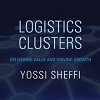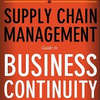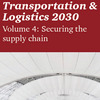 This is a guest post by Professor Yossi Sheffi, Director, MIT Center for Transportation & Logistics
This is a guest post by Professor Yossi Sheffi, Director, MIT Center for Transportation & Logistics
Many global supply chains benefit from the operational flexibility and distribution efficiencies provided by logistics clusters, yet we have a relatively poor understanding of these vital nodes. This lack of knowledge is even more pronounced when the broader economic benefits are considered.
One of the main motivations for writing my new book Logistics Clusters: Delivering Value and Driving Growth (MIT Press, October 2012), is to shed light on the crucial role played by logistics clusters in supply chain management and international commerce.
Logistics clusters are communities of companies that come together to share logistics expertise and know how. They can be found in most countries, often near consumer markets or within ports and airports. And they play host to a wide range of enterprises including the logistics arms of enterprises, third-party logistics services providers, distribution companies, and freight carriers.
In the loop
What advantages attract companies to these agglomerations? There are quite a few, not only for supply chain managers but also for the regions where these communities are located and for the global economy.
First, the growth of logistics clusters is self-reinforcing. They are the focal point of large volumes of freight, making it possible to achieve economies of scale and scope. Carriers and shippers use these gains to reduce the number of empty backhauls by identifying opportunities to pick up follow-on loads. And they exploit the scale of cluster-related freight activities by deploying larger conveyances to move freight and achieve higher vehicle utilization. Moreover, as the freight volumes in and out of logistics clusters grow, transportation service levels improve due to higher frequencies and more direct operations.
More efficient cargo flows lead to lower transportation costs and higher service levels, which attract additional companies to the cluster, creating a positive feedback loop. Further, by raising the efficiency bar they promote global growth, which increases the demand for cluster-based services and stimulates further trade growth.
Additionally, logistics clusters offer advantages based on the interchangeability of transportation and logistics assets. Since equipment such as rail cars, containers, trailers, and airplanes come in standard sizes and shapes, it can be shared by the community. The same goes for the logistics expertise that resides within these groupings. Sharing resources in this way enables the incumbents to withstand the variations in freight flows associated with the industries they serve.
A model for job creation
A powerful attribute – and one that is generally underestimated – is the ability of logistics clusters to create jobs. The port of Rotterdam employs 55,000 people directly and 90,000 indirectly. Los Angeles County supports more than 360,000 jobs in logistics. The Memphis International Airport in the U.S. is responsible for supports 220,000 jobs in the local economy, 95% of which are tied to cargo operations. In fact, more than one in three jobs in the Memphis area linked to the airport.
As I explain in the book, the employment opportunities in logistics clusters are wide ranging. There are blue collar jobs in areas such as warehousing, white collar positions in IT, customer service, and management, and work associated with value-add activities including light manufacturing and repairs. In its Louisville Worldport hub, UPS employs hardware technicians to repair Toshiba laptops, for instance.
These jobs are difficult to offshore, and not tied to the performance of a single industry. The late-stage customization of products that is carried in many clusters needs to be located in close proximity to end markets. In addition, the economics of transportation dictate that clusters should not be located too far from customers.
In many cases logistics clusters are also building highly valuable expertise in environmental sustainability. These freight hubs make it possible to improve vehicle utilization rates and to deploy larger conveyances, which lower the carbon footprints of supply chains.
The pitfalls
Logistics clusters also have a number of downsides that users should be aware of. Some local communities resent the noise, heavy traffic, and pollution that come with logistics clusters. In April 2012, a German court upheld a ban on night flights in Frankfurt Airport that restricts freight operations in the hub, for instance.
These entities are vulnerable to the economic downturns and geopolitical risks that are part and parcel of global trade. Rising energy prices and protectionist trade measures can undermine the viability of logistics clusters. Their competitiveness can also be affected by technological change. The port of Singapore, for instance, is investing in cranes that lift four containers simultaneously, making port operations faster and more efficient.
It should also be noted that not every logistics cluster is a success story; flawed decision making and inadequate resources can impede their development. Locations that initially appeared to be a perfect fit turn out to be less favorable. An example is Port Said at the northern mouth of the Suez Canal, which has not developed into the major global logistics hub envisaged by its creators.
Global competition is another factor to consider. Take for example, the expansion of the Panama Canal and the developing logistics clusters along the canal. This raises the competitive stakes on three fronts. First, there will be competition with transshipment ports in the Caribbean, Secondly, ports along the Atlantic Coast of the US and Latin America will compete to handle the larger container ships that the enlarged canal will attract. And thirdly, competition with other, non-canal routes is expected, specifically between the canal and the US Pacific Coast and rail combinations.
Bright future
Will these threats stymie the growth of logistics clusters? I think not. Trends such as globalization will continue to fuel the expansion of these communities. Indeed, as I argue in my book, more investment in logistics clusters is taking place in developing countries, notably China. Several European countries including Germany and the Netherlands are busy attracting logistics operations. Other countries should pay more attention to building and developing logistics clusters, so they can reap the full benefits that these remarkable communities have to offer.
Reference
Sheffi, Y. (2012). Logistics Clusters. MIT Press.
Author links
- mit.edu: Yossi Sheffi
- linkedin.com: Yossi Sheffi
Book website
- mit.edu: Logistics Clusters
Buy the book
Related posts
- husdal.com: Third party logistics – a risk orchestrator?
- husdal.com: 3PL outsourcing – challenges and benefits
Other books reviewed by husdal.com












